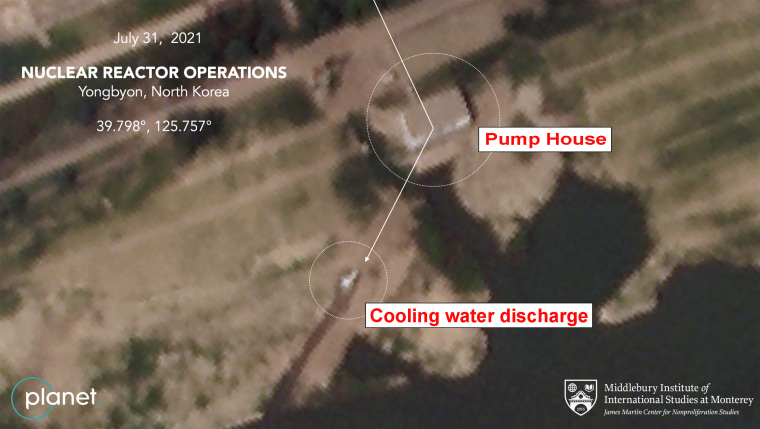WASHINGTON — A satellite image obtained by NBC News shows water flowing out of a North Korean reactor, the latest sign the regime has resumed work that could enable it to build more nuclear weapons.
The satellite photo, from Planet Labs and the Center for Nonproliferation Studies, appears to show a discharge of cooling water flowing out of the reactor into a channel leading to the nearby Kuryong river.
The commercial satellite photo, dated Aug. 25, suggests the regime intends to add to its nuclear arsenal and is making no effort to conceal its activity at the Yongbyon plutonium reactor, said Jeffrey Lewis, director of the East Asia Nonproliferation Program at the Center for Nonproliferation Studies at the Middlebury Institute of International Studies at Monterey.
"The only reason this reactor operates is to make nuclear weapons. The fact that it's running means they're going to add to their nuclear weapons stockpile," Lewis said. "They are making nuclear weapons and they don't care that we can see it."
On Sunday, the International Atomic Energy Agency said there were indications North Korea had renewed activity at the Yongbyon reactor.
The IAEA called the resumed operations at the reactor "deeply troubling." The Wall Street Journal first reported the IAEA's findings.
The Yongbyon reactor appeared to have been inactive from December 2018 until the beginning of July 2021, according to the IAEA. But since early July, "there have been indications, including the discharge of cooling water, consistent with the operation of the reactor," the IAEA said.
The agency also said North Korea appeared to be using a laboratory nearby to separate plutonium from spent fuel previously removed from the reactor.
Signs of more activity at Yongbyon come at a "dangerous" moment, Lewis said, after Pyongyang announced plans earlier this year to develop shorter-range, tactical nuclear weapons.
At a summit in 2019 in Vietnam with then U.S. President Donald Trump, North Korean leader Kim Jong Un offered to dismantle Yongbyon in return for the lifting of an array of international sanctions. But the U.S. rejected the proposal as insufficient to justify easing economic sanctions.
The Biden administration says it has offered to hold talks with North Korea but the regime turned down the offer, saying it won't negotiate without a change in Washington's stance.
